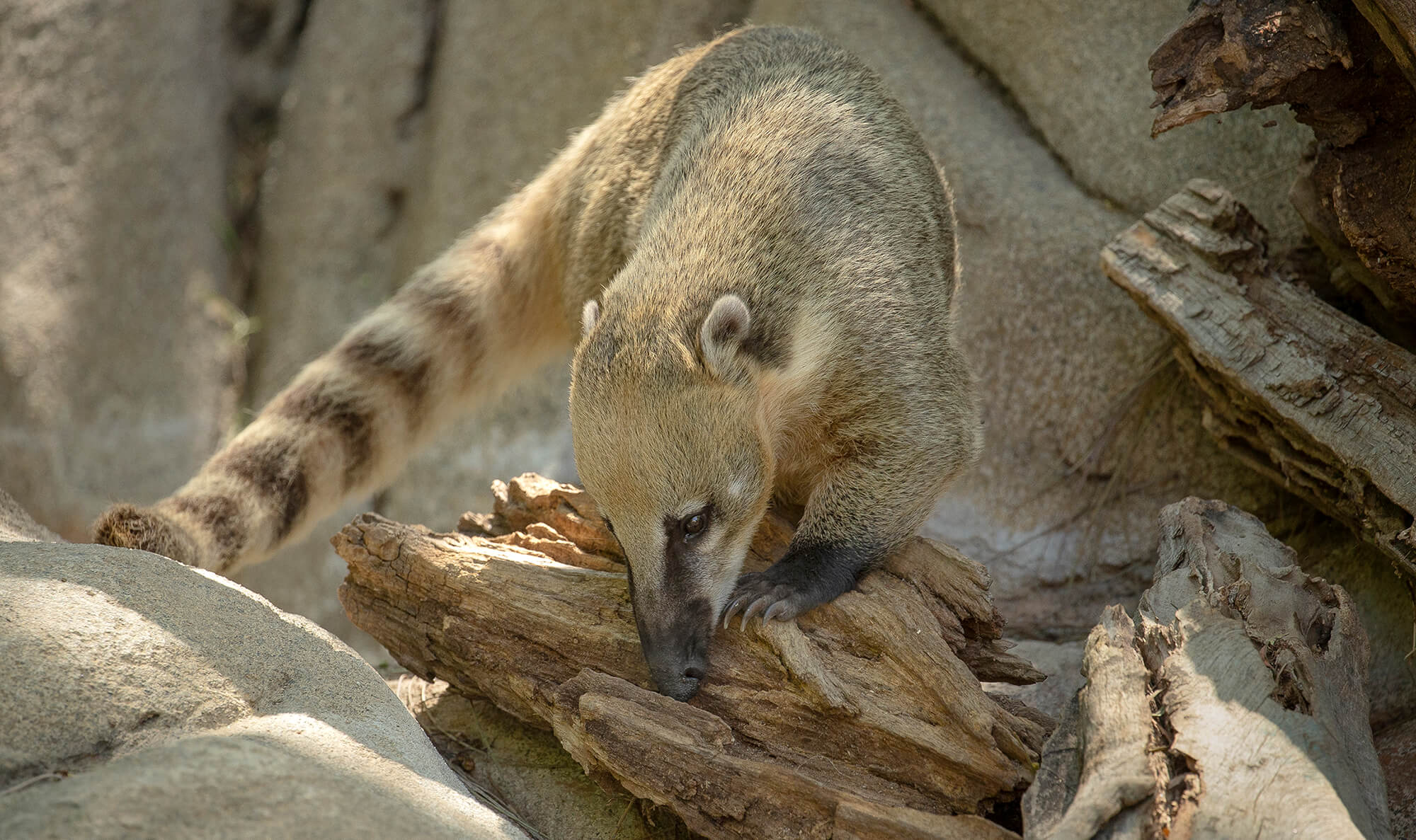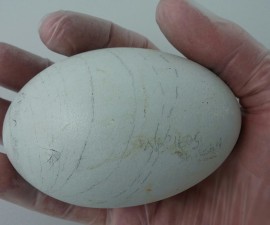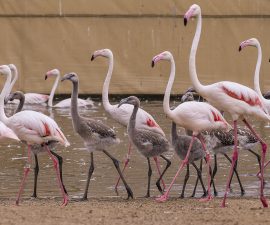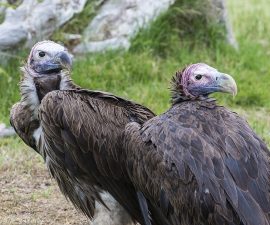
Curious Coatis
Not a monkey, a dog, a cat, or even a pig—the inquisitive, gregarious coati is truly one of a kind
BY Eston Ellis
Photography by Tammy Spratt
With the curiosity and tree-climbing agility of a monkey, the curled-up napping posture of a cat, the eager and gregarious nature of a dog, and the built-for-rooting snout of a pig, it’s no wonder that many people are confused about just what kind of animal a coati is. The coati’s long, ringed, raccoon-like tail, however, provides a clue about its family tree. Coatis are members of the Procyonidae family of New World mammals, which also includes ringtails, kinkajous, olingos, and raccoons. Unlike all the Procyonidae, which are nocturnal, coatis are active during the day.
The name—pronounced ko-WAH-tee—is also a source of confusion. For many years, all coatis were inaccurately referred to as “coatimundis”—a word that actually describes a lone male coati, not an entire species. The name coati is derived from two words in the language of the Tupi people of Brazil: cua meaning “belt” and tim meaning “nose,” referring to the way coatis sleep—curled up with their long nose tucked against their belly.
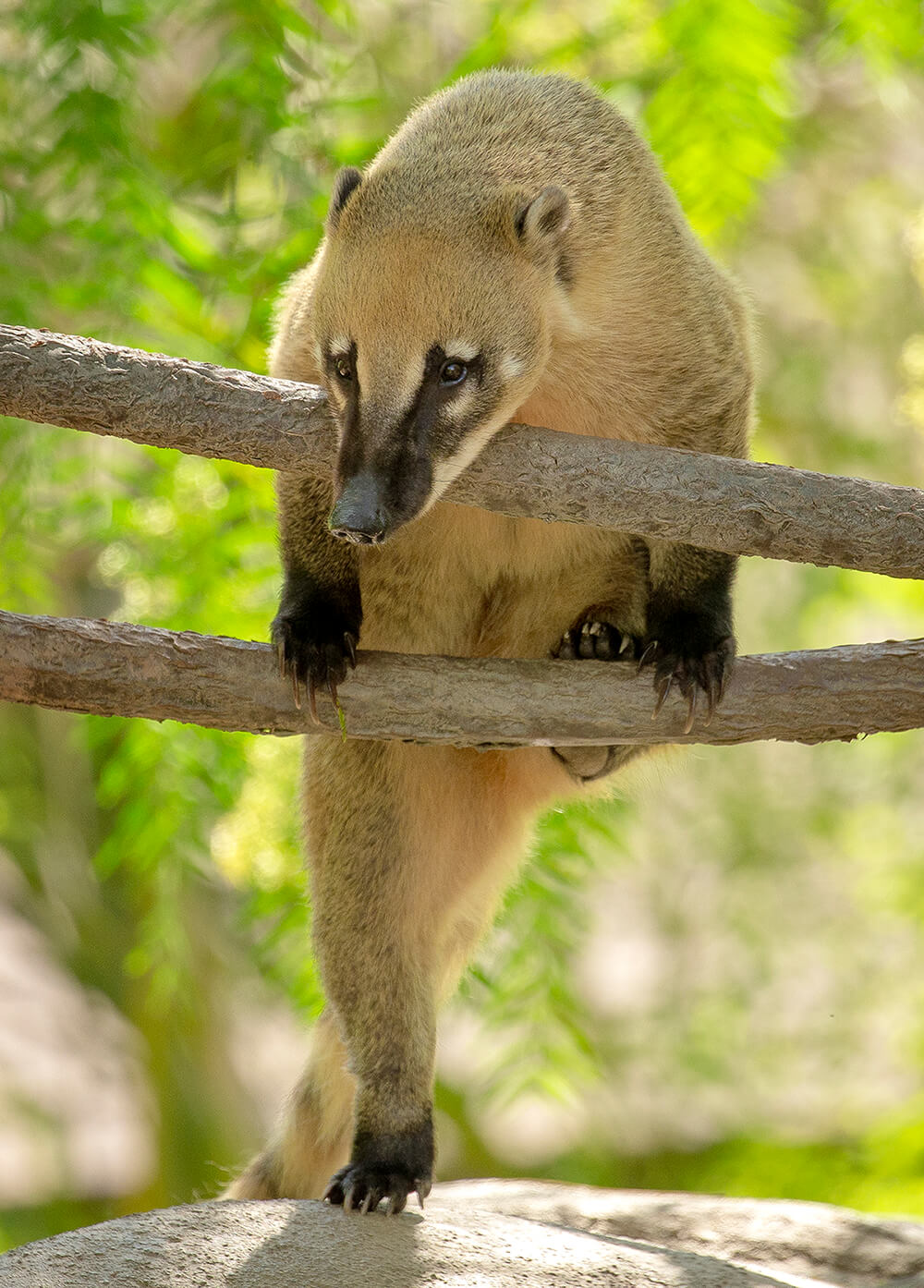
BUILT FOR CLIMBING
Coatis spend much of their time in trees, and they are excellent climbers—thanks to sharp claws for holding on, a long tail for balancing along branches, and reverse joints on their back feet to climb down headfirst.
Some coatis are about the size of a large house cat—but it varies, depending on the species (there are four). Weight ranges from 5 to 20 pounds— males are larger than females—and an adult’s body length ranges from 15 to 26 inches. The coati’s distinctive ringed tail, which it often holds erect as it walks, is nearly as long as its body.
That long tail comes in handy when coatis are climbing trees or making their way through the canopy of a rain forest or cloud forest. They use it for balance, traipsing along branches high in the treetops. Coatis have long claws on their front feet (and shorter ones on the back feet) that help them climb and dig through rotting logs or dirt to find insects to eat. Reverse joints on their ankles allow them to descend trees headfirst. Webbing between their toes makes them surprisingly good swimmers.
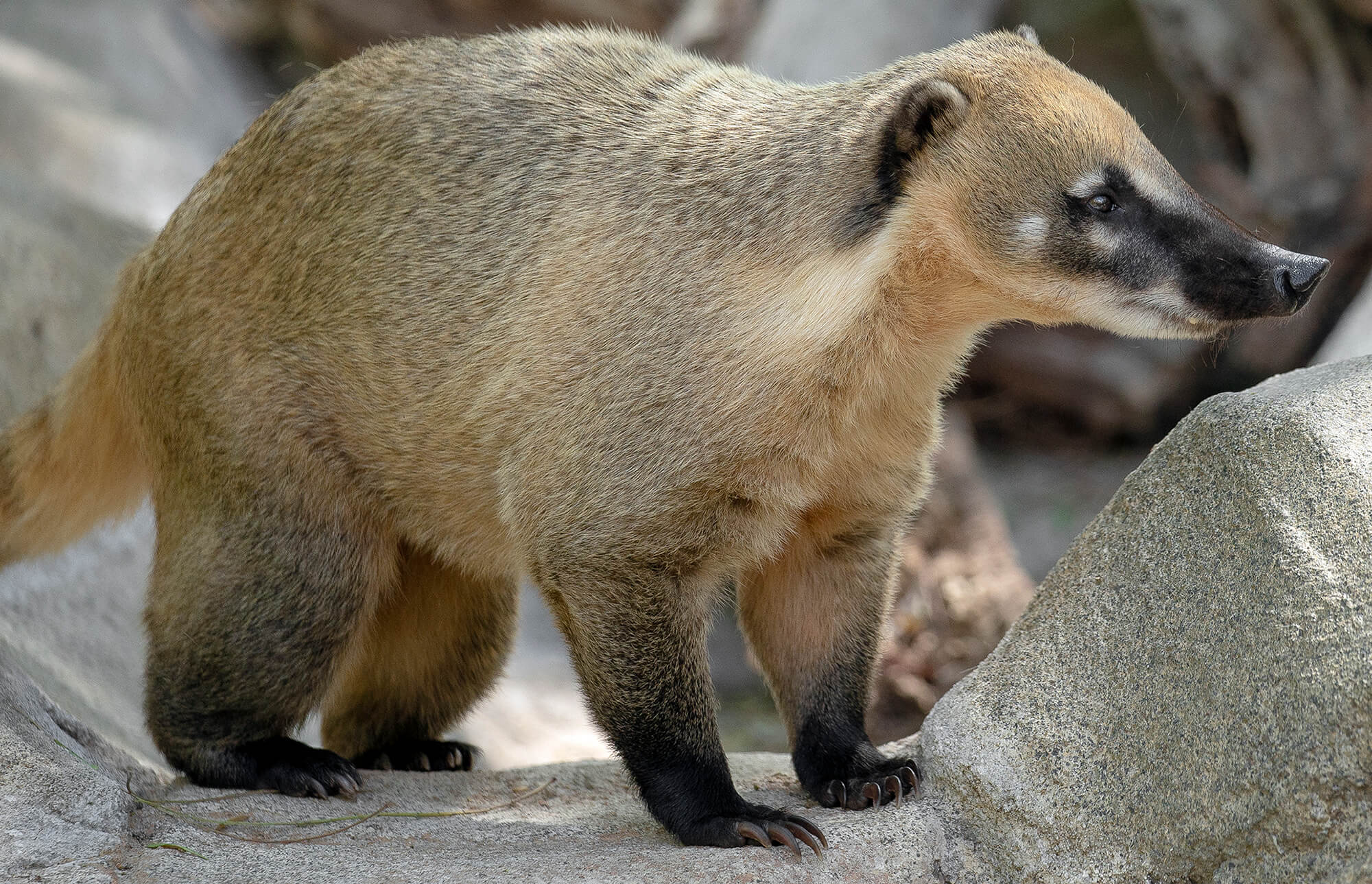
SNIFFING FOR SNACKS
The coati uses its powerful sense of smell to find food, and can use its strong, bendable snout to root along the forest floor for fallen fruit, insects, lizards, and other treats.
Most noticeable about a coati’s face is its long nose and prominent snout. Their sense of smell is highly sensitive, and that long, muscular snout can bend up to 60 degrees to sniff out food—and then root through leaf litter for a tasty snack. A group of coatis may travel about 1.5 miles looking for food, foraging both on the ground and in the trees. They are omnivores, consuming fruit, grubs, insects, lizards, small birds, and sometimes even carrion.
These social animals live in groups of groups of 4 to 24 adult females and juvenile offspring. They forage together, participate in cooperative grooming, and keep a lookout for potential predators. One adult male joins the group during mating season, breeding with multiple females, after which he is encouraged to leave the group. After that short stint, males live alone. A female leaves her group to give birth to a litter of three to seven kits in a nest she has constructed in the trees. She nurtures her kits for their first six weeks, then they rejoin the group.
The four species of coati are found in forest and grassland habitats from South America to Mexico, and in parts of the Southwestern US. The South American coati Nasua nasua and the white-nosed coati Nasua narica seen in Mexico and the US have stable populations, and are both categorized as species of least concern on the International Union for Conservation of Nature (IUCN) Red List of Threatened Species. The eastern mountain coati Nasuella meridensis is known to live in only five confirmed locations in Venezuela, in an area of about 297 square miles, and is listed as Endangered; and the western mountain coati Nasuella olivacea, native to the Andes of Colombia, Venezuela, and Ecuador, is categorized as Near Threatened. Mountain coatis are slightly smaller than their more common cousins.
All coatis face many threats in the wild—including predation from jaguars, boa constrictors, eagles, dogs and other animals; hunting by humans; and habitat loss or degradation from increasing human development. In the wild, coatis have an average life span of 7 years, although they may live up to 15 years in zoos.
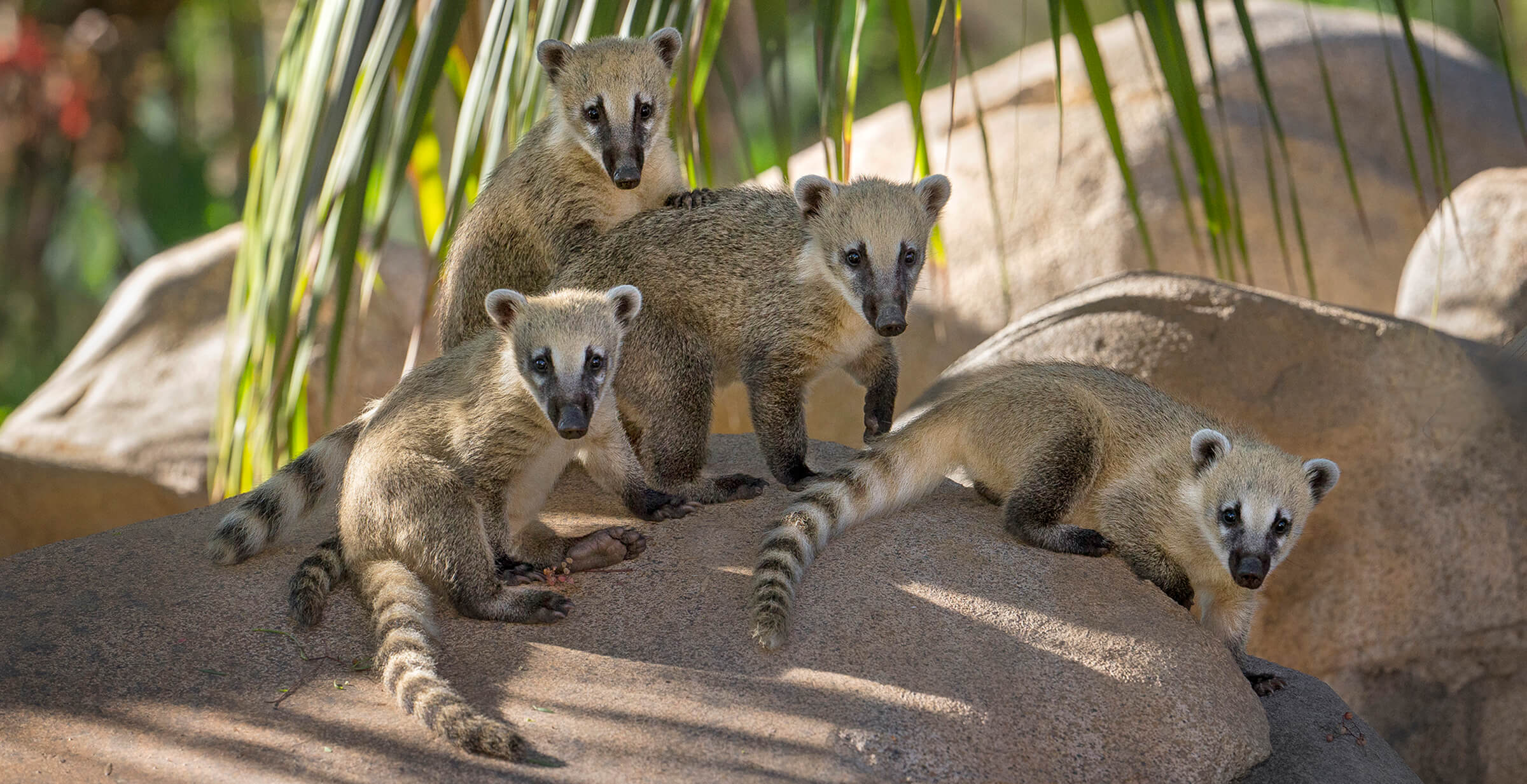
Meet the Park Coatis
At the San Diego Zoo Safari Park, the coati exhibit is sort of “hidden in plain sight” next to the Thorntree Terrace restaurant—the best vantage point for coati watching is actually the outdoor dining area, which is separated from the exhibit by a glass wall. Our group of five coatis—two males and three females—are non-breeding littermates born in April 2014 that were raised together. “They were teensy when they got here,” said Sue Evans, senior keeper.
Johnny and Jasper are the two males, and Johnny is by far the most gregarious of the entire group. “Johnny is always the first to come out when there’s enrichment, and he’s usually the first in line,” Sue said. Peanut is the smallest of the three females and is shy, like her sister Jenny. Their sister Squirt is “the boss,” Sue explained. “But if there’s a toy around, Jenny will take it…and then it’s hers! Their favorite toy is anything they can unwrap, rip up, or somehow get into. If we give them little boxes wrapped in a paper towel, it’s like Christmas morning. They love opening boxes.”
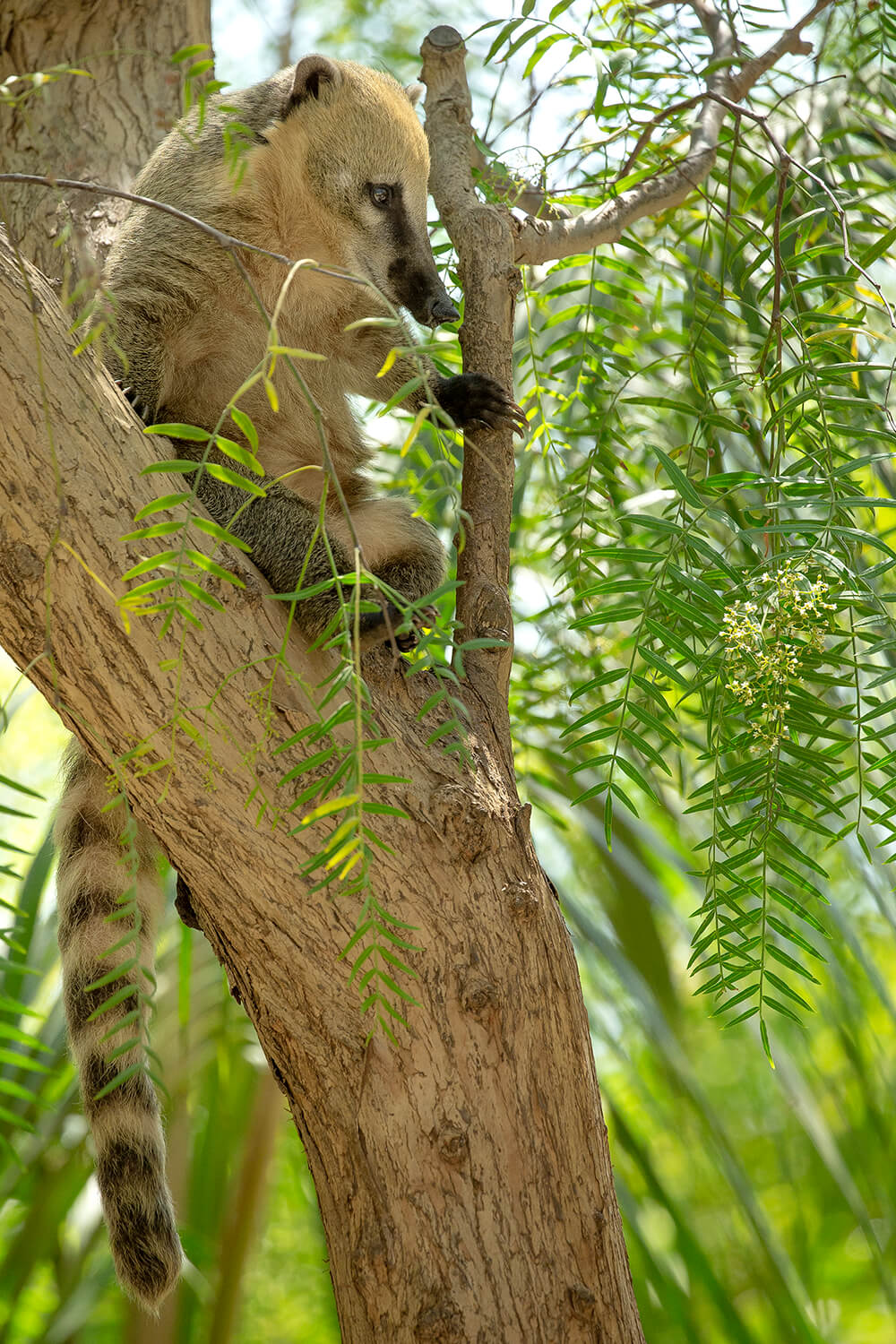
LOOK UP THERE
The coatis at the Safari Park can often be seen climbing, traversing branches and vine-like ropes, or lounging in their exhibit’s large California pepper tree.
The exhibit is full of surprises for the coatis to keep them engaged and interested in exploring, and providing opportunities to use natural behaviors. One day, they may find treats in their exhibit that are wrapped up in a container they have to figure out how to open, or placed in a puzzle feeder. Other days, there may be a seasonal treat, like a pumpkin.
The exhibit features a large California pepper tree—a hot spot for the coatis. The exhibit has many other features, including a hammock into which they sometimes all pile, a swinging platform that hangs from the tree, thick vine-like ropes to traverse, rocks to climb, and a heated rocky area with an overhang that provides shelter from sun or rain (which came in handy this past spring). There’s rarely a dull moment, as these inquisitive and energetic mammals explore every nook and cranny of their habitat. They can often be seen using their claws to dig their way through logs—a natural behavior they use to find insects to eat. “They love this wood,” Sue explained. “They dig at it, hollow out little holes, and keep working at it—until they eventually just make mulch out of it.”

NOT RACCOONS
Coatis are omnivorous and have a ringed tail like their raccoon cousins—but unlike nocturnal raccoons, coatis are active during the day.
Enrichment takes many shapes: a “cookie tunnel” chute that moves up and down like a seesaw, running on a giant “hamster wheel,” and a variety of food puzzles. Among their favorites are webbed hanging boxes that volunteers have crafted out of woven fire hose, which contain treats that require dexterity, strategy, and patience to discover. In addition to foraging opportunities, they are fed a balanced diet every day. “When I feed them in the morning, they always line themselves up in the very same order,” Sue said.
In the wild, males and females live separately except during mating season. At the Safari Park, the two groups separate at night. “The females sleep together, and the males sleep together, as is their natural behavior,” Sue said. “During the day, they play together very nicely, but they don’t get along as well at night.”
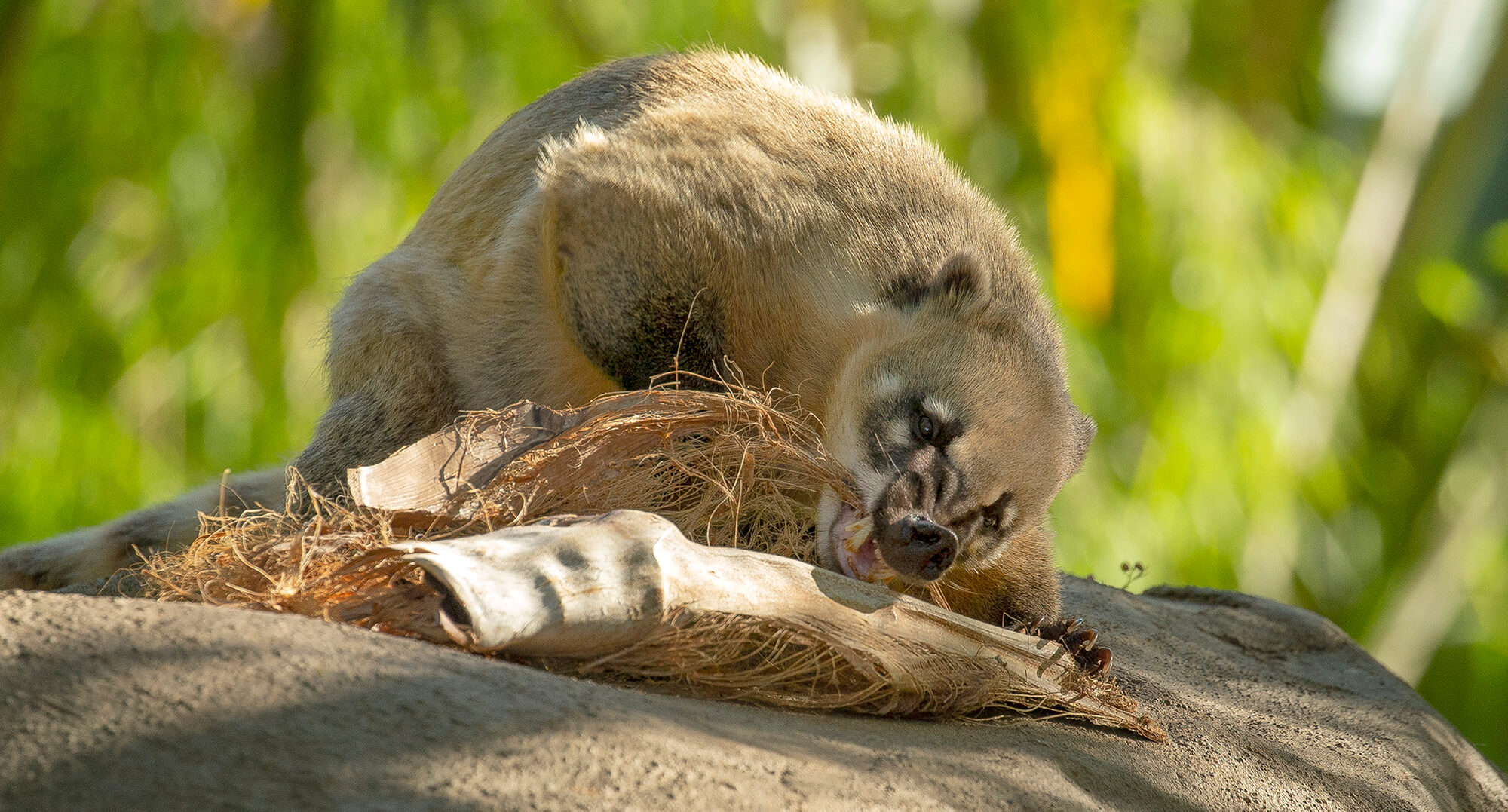
ANOTHER DAY, ANOTHER DISCOVERY
For the coatis at the Safari Park, there’s never a dull moment—whether they’re searching for hidden treats in their exhibit, building sleeping nests in their off-exhibit quarters, or using their natural behaviors in enriching experiences with an ever-changing variety of items to explore.
Coatis in the wild build sleeping nests in trees. And the coatis at the Safari Park create their own versions of those nests in their off-exhibit bedrooms, Sue said. “If they have a favorite thing, they will put it in their beds, like the way they make sleeping nests in trees. They’re like hoarders with a favorite toy or something they’ll find. We could make a nest for them, but they prefer to do it themselves.”
Coatis make many different sounds, and some are specific to eating and enjoying food. “There’s a special squeaky sound they make if one of us asks ‘are you hungry?’ and a chattering sound if something exciting is going on,” Sue said. “I love how they react to enrichment. They’re the best—although meerkats are a close second,” she added with a laugh.
“They are super active as soon as they enter the exhibit in the morning, then they start exploring and climbing. Maybe they’ll sleep for a little bit—but then the fun starts up again.”

